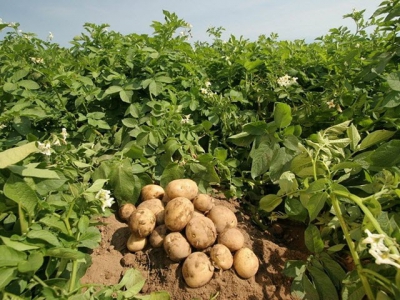Controlling nitrogen application is important

Your basic fertilisation of the potato crop should have been done according to a soil analysis, leaving the main variable, nitrogen, to be managed as circumstances require.
All the other elements will only have the capacity for slight movement in the soil – not so nitrogen, which is needed to accelerate the growth of the potato plants. Vigorous, later maturing varieties can have 20% to 50% of the required nitrogen applied at planting. Earlier, more compact growers can do with more. This is only a guideline, as the area and season will also have an effect.
Leaching
In some cases, nitrogen may be lost in one heavy rainstorm and moved beyond the root system in its nitrate form. If there’s a likelihood of much rain in the early stages, less nitrogen must be applied at planting and provision made for more frequent, lighter applications later. Much, if not all, the nitrogen applied with the basic fertiliser will be in the form of ammonia, which won’t leach until converted by soil bacteria to nitrate.
This conversion can take place in a few days in warm conditions. The tubers will start to form 20 to 40 days after planting. Growth should not be interrupted through lack of water or nitrogen. Two-thirds of the nitrogen should be applied by 75 days after transplanting. Once the tubers have started forming, the plant will start to take up a lot more nitrogen. This will continue up to two to three weeks before maturity. The nitrogen isn’t only for the tubers, but also for the leaf growth needed to fill the gaps between the rows.
With early maturing potato cultivars in the early, drier season, you can often get away with basic fertilisation and one side-dressing. If in doubt, rather divide up applications. The health and colour of the leaves will be a good indication of the necessity for further applications. The colour will become lighter for the last few weeks.
Delayed
Too much nitrogen early on, when vigorous, late-maturing varieties are grown, can result in delayed tuber formation and bulking of the tubers. About half the nitrogen and potassium is taken up by the time the plants touch between the rows. About one-third of the phosphorus is also taken up by this time.
Nitrogen can be applied through the irrigation system. This makes it easier to apply smaller, more frequent doses to try and control leaching. Leaching is also influenced by the soil type, with sandy soils being very vulnerable. A higher organic matter content not only makes for a healthy, productive crop, but also reduces leaching. From a scab perspective, those whose crop is growing in acid soils can apply some calcium as a foliar spray of calcium nitrate.
The same goes for instances where the potassium is a bit on the low side – you can top up with potassium nitrate, which is two-thirds potassium. Apply it either as a foliar spray or through the irrigation system.
Quality
Potassium and calcium are important elements for potatoes when it comes to internal quality, taste and storage life. If the colour of the leaves indicates nitrogen levels are on the low side at a stage when the tubers are bulking up, do an emergency urea foliar spray, using about 4kg/ha. This is not a lot of nitrogen, but will immediately get the level of this element up in the leaves for quick correction. This shouldn’t replace a soil application, but rather supplement it.
Trace elements required can be identified by soil analysis, either directly by seeing which elements are low, or by the soil pH, which can indicate which trace elements may be rendered unavailable. You can then look out for any symptoms and correct with a foliar feed.
Related news
Tools

Phối trộn thức ăn chăn nuôi

Pha dung dịch thủy canh

Định mức cho tôm ăn

Phối trộn phân bón NPK

Xác định tỷ lệ tôm sống

Chuyển đổi đơn vị phân bón

Xác định công suất sục khí

Chuyển đổi đơn vị tôm

Tính diện tích nhà kính

Tính thể tích ao



 Vietnam’s tea exports fall 6.9 percent in revenue
Vietnam’s tea exports fall 6.9 percent in revenue  Vietnam exports less, but earns more from cassava
Vietnam exports less, but earns more from cassava